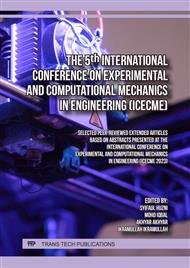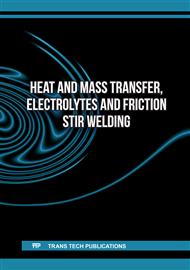[1]
R. McElveen, K. Lyles, B. Martin, and W. Wasserman, "Reliability of Cooling Tower Drives: Improving Efficiency with New Motor Technology," IEEE Ind. Appl. Mag., vol. 18, no. 6, p.12–19, 2012.
DOI: 10.1109/MIAS.2012.2210090
Google Scholar
[2]
Z. Zhang, M. Gao, Z. Dang, S. He, and F. Sun, "An exploratory research on performance improvement of super-large natural draft wet cooling tower based on the reconstructed dry-wet hybrid rain zone," Int. J. Heat Mass Transf. J., vol. 142, p.1–13, 2019.
DOI: 10.1016/j.ijheatmasstransfer.2019.118465
Google Scholar
[3]
C. G. Cutillas, J. R. Ramírez, and M. L. Miralles, "Optimum design and operation of an HVAC cooling tower for energy and water conservation," Energies, vol. 10, no. 3, p.1–27, 2017.
DOI: 10.3390/en10030299
Google Scholar
[4]
R. K. Singla, K. Singh, and R. Das, "Tower characteristics correlation and parameter retrieval in wet-cooling tower with expanded wire mesh packing," Appl. Therm. Eng., vol. 96, p.240–249, 2016.
DOI: 10.1016/j.applthermaleng.2015.11.063
Google Scholar
[5]
A. Zargar et al., "Numerical analysis of a counter-flow wet cooling tower and its plume," Int. J. Thermofluids, vol. 14, no. February, 2022.
DOI: 10.1016/j.ijft.2022.100139
Google Scholar
[6]
B. K. Naik and P. Muthukumar, "A novel approach for performance assessment of mechanical draft wet cooling towers," Appl. Therm. Eng., vol. 121, p.14–26, 2017.
DOI: 10.1016/j.applthermaleng.2017.04.042
Google Scholar
[7]
P. Navarro, J. Ruiz, A. S. Kaiser, and M. Lucas, "Effect of fill length and distribution system on the thermal performance of an inverted cooling tower," Appl. Therm. Eng., vol. 231, p.120876, 2023.
DOI: 10.1016/j.applthermaleng.2023.120876
Google Scholar
[8]
K. Singh and R. Das, "An experimental and multi-objective optimization study of a forced draft cooling tower with different fills," Energy Convers. Manag., vol. 111, p.417–430, 2016.
DOI: 10.1016/j.enconman.2015.12.080
Google Scholar
[9]
S. Shetty, S. S. Salins, and S. Kumar, "Influence of packing configuration and flow rate on the performance of a forced draft wet cooling tower," J. Build. Eng. j, vol. 72, no. February, p.1–20, 2023.
DOI: 10.1016/j.jobe.2023.106615
Google Scholar
[10]
J. Yang, Z. Jia, H. Guan, S. He, and M. Gao, "Influence of three different pitches fillings on the cooling performance of wet cooling towers under crosswind," Appl. Therm. Eng., vol. 220, p.119760, 2023.
DOI: 10.1016/j.applthermaleng.2022.119760
Google Scholar
[11]
P. J. Grobbelaar, H. C. R. Reuter, and T. P. Bertrand, "Performance characteristics of a trickle fill in cross- and counter- flow configuration in a wet-cooling tower," Appl. Therm. Eng., vol. 50, p.475–484, 2013.
DOI: 10.1016/j.applthermaleng.2012.06.026
Google Scholar
[12]
S. R. Alavi and M. Rahmati, "Experimental investigation on thermal performance of natural draft wet cooling towers employing an innovative wind-creator setup," Energy Convers. Manag., vol. 122, p.504–514, 2016.
DOI: 10.1016/j.enconman.2016.06.016
Google Scholar
[13]
M. Gao, J. Zou, S. He, and F. Sun, "Thermal performance analysis for high level water collecting wet cooling tower under crosswind conditions," Appl. Therm. Eng., vol. 136, no. February, p.568–575, 2018.
DOI: 10.1016/j.applthermaleng.2018.03.043
Google Scholar
[14]
Y. Zhou, K. Wang, M. Gao, Z. Dang, S. He, and F. Sun, "Experimental study on the drag characteristic and thermal performance of non-uniform fi llings for wet cooling towers under crosswind conditions," Appl. Therm. Eng., vol. 140, no. May, p.398–405, 2018.
DOI: 10.1016/j.applthermaleng.2018.05.071
Google Scholar
[15]
Y. Zhou, M. Gao, G. Long, Z. Zhang, Z. Dang, and S. He, "Experimental study regarding the effects of forced ventilation on the thermal performance for super-large natural draft wet cooling towers," Appl. Therm. Eng., vol. 155, no. March, p.40–48, 2019.
DOI: 10.1016/j.applthermaleng.2019.03.149
Google Scholar
[16]
Z. Cui, Q. Du, J. Gao, and R. Bie, "Optimum design of a deep cooling tower for waste heat and water recovery from humid flue gas," Case Stud. Therm. Eng., vol. 49, no. May, p.103317, 2023.
DOI: 10.1016/j.csite.2023.103317
Google Scholar
[17]
S. Kumar et al., "Estimation of performance parameters of a counter flow cooling tower using biomass packing," Therm. Sci. Eng. Prog. J., vol. 44, no. February, p.1–11, 2023.
Google Scholar
[18]
M. Lemouari, M. Boumaza, and A. Kaabi, "Experimental analysis of heat and mass transfer phenomena in a direct contact evaporative cooling tower," Energy Convers. Manag., vol. 50, no. 6, p.1610–1617, 2009.
DOI: 10.1016/j.enconman.2009.02.002
Google Scholar
[19]
P. Navarro, J. Ruiz, M. Hernández, A. S. Kaiser, and M. Lucas, "Critical evaluation of the thermal performance analysis of a new cooling tower prototype," Appl. Therm. Eng., vol. 213, no. January, p.118719, 2022.
DOI: 10.1016/j.applthermaleng.2022.118719
Google Scholar
[20]
P. Imani-mofrad, Z. Heris, and M. Shanbedi, "Experimental investigation of filled bed effect on the thermal performance of a wet cooling tower by using ZnO / water nanofluid," Energy Convers. Manag. J., vol. 127, p.199–207, 2016.
DOI: 10.1016/j.enconman.2016.09.009
Google Scholar
[21]
K. Singh and R. Das, "A feedback model to predict parameters for controlling the performance of a mechanical draft cooling tower," Appl. Therm. Eng., vol. 105, p.519–530, 2016.
DOI: 10.1016/j.applthermaleng.2016.03.030
Google Scholar
[22]
S. T. Dehaghani, H. Ahmadikia, and H. Ahmadikia, "Retrofit of a wet cooling tower in order to reduce water and fan power consumption using a wet / dry approach," Appl. Therm. Eng., 2017, doi: http://dx.doi.org/.
DOI: 10.1016/j.applthermaleng.2017.07.069
Google Scholar
[23]
B. Yang, X. Liu, Z. Zhao, J. Song, and C. Chen, "The analysis of the influence of packing and total pressure on cooling performance of the cooling tower," in IOP Conference Series: Earth and Environmental Science, 2018, vol. 170, no. 3, p.1–8.
DOI: 10.1088/1755-1315/170/3/032020
Google Scholar
[24]
J. Liao, X. Xie, H. Nemer, D. E. Claridge, and C. H. Culp, "A simplified methodology to optimize the cooling tower approach temperature control schedule in a cooling system," Energy Convers. Manag., vol. 199, no. June, p.111950, 2019.
DOI: 10.1016/j.enconman.2019.111950
Google Scholar
[25]
L. Jiang et al., "The effects of water droplet diameter distribution in the rain zone on the cooling capacity and water-splashing noise for natural draft wet cooling towers," Int. J. Therm. Sci., vol. 164, no. August 2020, 2021.
DOI: 10.1016/j.ijthermalsci.2021.106875
Google Scholar
[26]
Z. Zhang, D. Zhang, Q. Han, F. Wu, M. Gao, and S. He, "Numerical simulation on the three kinds of water droplet diameter treatments in rain zone of wet cooling towers," Int. J. Heat Mass Transf., vol. 170, p.1–11, 2021.
DOI: 10.1016/j.ijheatmasstransfer.2021.121054
Google Scholar
[27]
D. Lyu, F. Sun, and Y. Zhao, "Impact mechanism of different fill layout patterns on the cooling performance of the wet cooling tower with water collecting devices," Appl. Therm. Eng., vol. 110, p.1389–1400, 2017, doi: https://doi.org/10.1016/j.applthermaleng. 2016.08.190.
DOI: 10.1016/j.applthermaleng.2016.08.190
Google Scholar
[28]
K. Chen, F. Sun, L. Zhang, X. Chen, and X. Zhang, "A sensitivity-coefficients method for predicting thermal performance of natural draft wet cooling towers under crosswinds," vol. 206, no. August 2021, 2022.
DOI: 10.1016/j.applthermaleng.2022.118105
Google Scholar
[29]
A. V Dmitriev, I. N. Madyshev, V. V Kharkov, O. S. Dmitrieva, and V. E. Zinurov, "Experimental investigation of fill pack impact on thermal-hydraulic performance of evaporative cooling tower," Therm. Sci. Eng. Prog., vol. 22, p.100835, 2021.
DOI: 10.1016/j.tsep.2020.100835
Google Scholar
[30]
Umurani, K., Muharnif, M., Rahmatullah, R., & Tanjung, I, "Characterization of heat transfer enhancement and pressure drop in rectangular channel featuring different V-ribs construction". in AIP Conference Proceedings, 2023, November, vol. 2702, no. 1). AIP Publishing.
DOI: 10.1063/5.0185755
Google Scholar
[31]
R. Ramkumar and A. Ragupathy, "Optimization of cooling tower performance with different types of packings using Taguchi approach," J. Brazilian Soc. Mech. Sci. Eng., vol. 37, no. 3, p.929–936, 2015.
DOI: 10.1007/s40430-014-0216-1
Google Scholar
[32]
H. Ma, L. Cai, F. Si, and J. Wang, "Exploratory research on annular-arranged moist media to improve cooling capacity of natural draft dry cooling tower and thermo-flow characteristics of its radiators," Int. J. Heat Mass Transf., vol. 172, p.121123, 2021.
DOI: 10.1016/j.ijheatmasstransfer.2021.121123
Google Scholar
[33]
Khairul Umurani, Rahmatullah, Arya Rudi Nasution, M.Sayid Zuhfri, "Design and implementation of temperature measuring device using max6675 and thermocouple on wet cooling tower," Jurnal Rekaya Material, Manufaktur Energy., vol. 7, p.335–342, 2024
Google Scholar



